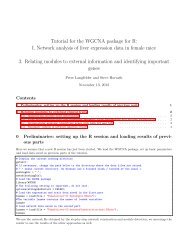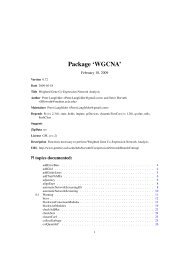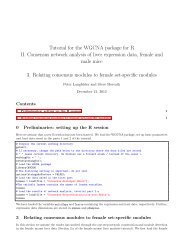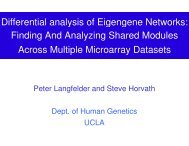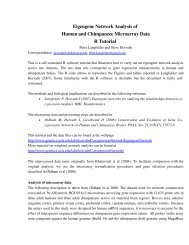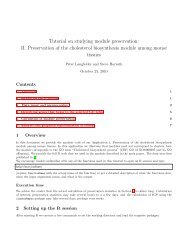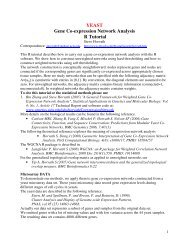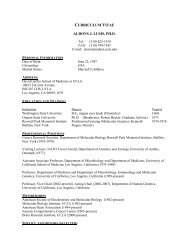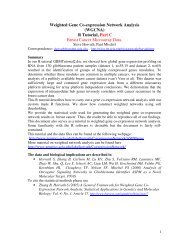Package 'WGCNA' - Laboratory Web Sites - UCLA
Package 'WGCNA' - Laboratory Web Sites - UCLA
Package 'WGCNA' - Laboratory Web Sites - UCLA
Create successful ePaper yourself
Turn your PDF publications into a flip-book with our unique Google optimized e-Paper software.
18 blockwiseConsensusModules<br />
blocks<br />
blockOrder<br />
originCount<br />
if input blocks was given, its copy; otherwise a vector of length equal number<br />
of genes giving the block label for each gene. Note that block labels are not<br />
necessarilly sorted in the order in which the blocks were processed (since we do<br />
not require this for the input blocks). See blockOrder below.<br />
a vector giving the order in which blocks were processed and in which blockGenes<br />
above is returned. For example, blockOrder[1] contains the label of the<br />
first-processed block.<br />
if the input consensusQuantile==0, this vector will contain counts of how<br />
many times each set contributed the consensus gene similarity value. If the<br />
counts are highly unbalanced, the consensus may be biased.<br />
TOMScalingSamples<br />
if the input getTOMScalingSamples is TRUE, this component is a list with<br />
one component per block. Each component is again a list with two components:<br />
sampleIndex contains indices of the distance structure in which TOM is<br />
stored that were sampled, and TOMSamples is a matrix whose rows correspond<br />
to TOM samples and columns to individual set. Hence, TOMScalingSamples[[blockNo]]$TO<br />
setNo] contains the TOM entry that corresponds to element TOMScalingSamples[[blockNo]<br />
of the TOM distance structure in block blockNo and set setNo. (For details<br />
on the distance structure, see dist.)<br />
Note<br />
If the input datasets have large numbers of genes, consider carefully the maxBlockSize as it significantly<br />
affects the memory footprint (and whether the function will fail with a memory allocation<br />
error). From a theoretical point of view it is advantageous to use blocks as large as possible; on the<br />
other hand, using smaller blocks is substantially faster and often the only way to work with large<br />
numbers of genes. As a rough guide, it is unlikely a standard desktop computer with 4GB memory<br />
or less will be able to work with blocks larger than 7000 genes.<br />
Author(s)<br />
Peter Langfelder<br />
References<br />
Langfelder P, Horvath S (2007) Eigengene networks for studying the relationships between coexpression<br />
modules. BMC Systems Biology 2007, 1:54<br />
See Also<br />
goodSamplesGenesMS for basic quality control and filtering;<br />
adjacency, TOMsimilarity for network construction;<br />
hclust for hierarchical clustering;<br />
cutreeDynamic for adaptive branch cutting in hierarchical clustering dendrograms;<br />
mergeCloseModules for merging of close modules.



